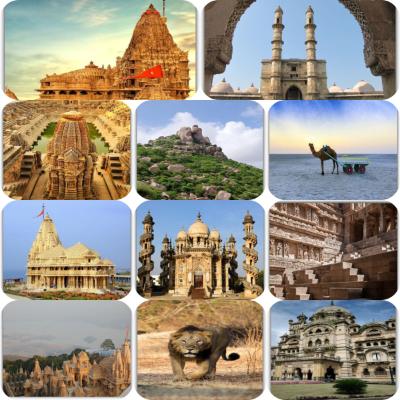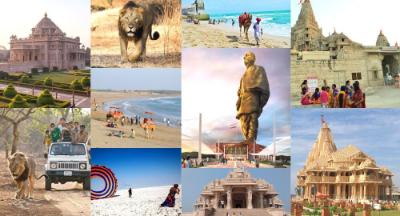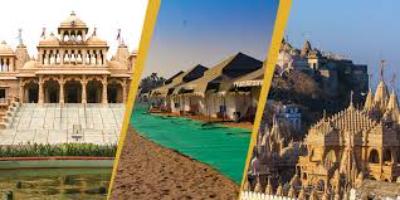Gujarat’s Water Conservation Marvels: Ancient Stepwells and Tanks
Gujarat, the westernmost state of India, is not only known for its vibrant culture, delicious food, and historic monuments but also for its unique water conservation marvels. The arid climate of Gujarat has led its inhabitants to develop innovative systems to conserve water for centuries. Ancient stepwells and tanks, also known as baolis and talavs respectively, are remarkable examples of these sustainable water management practices. In this blog post, we will explore some of Gujarat's magnificent stepwells and tanks, highlighting their historical significance and architectural beauty.
1. Rani ki Vav, Patan:
Rani ki Vav, located in the town of Patan, is one of the most impressive stepwells in Gujarat. Built in the 11th century by Queen Udayamati as a memorial to her husband King Bhimdev I, this UNESCO World Heritage Site is a masterpiece of Maru-Gurjara architecture. The stepwell is intricately carved with over 800 sculptures, depicting scenes from Hindu mythology, celestial beings, and everyday life. Rani ki Vav not only served as a water source but also as a social and cultural gathering place.
2. Adalaj Stepwell, Ahmedabad:
Another magnificent stepwell in Gujarat is the Adalaj Stepwell, situated on the outskirts of Ahmedabad. Built in 1499 by Queen Rudabai, the stepwell showcases stunning Indo-Islamic architecture. The intricately carved pillars, arches, and galleries are a testament to the craftsmanship of that era. The stepwell consists of five levels and a three-story octagonal well shaft. Adalaj Stepwell served as a resting place and a cool retreat for travelers and pilgrims.
3. Dada Harir Stepwell, Ahmedabad:
Dada Harir Stepwell, also known as Bai Harir Vav, is one of the oldest and deepest stepwells in Gujarat. Built in the 15th century by Bai Harir, a noblewoman, this stepwell features stunning architectural elements such as ornate pillars, galleries, and intricate carvings. The stepwell is divided into three distinct sections and descends to a depth of over 30 meters. Dada Harir Stepwell served as a water source for the surrounding communities.
4. Surya Kund, Modhera:
Located near the famous Sun Temple in Modhera, Surya Kund is a large stepwell featuring exquisite carvings and intricate geometrical patterns. It was built in the 11th century as a sacred water tank for performing rituals and ceremonies before visiting the temple. The stepwell has more than 100 shrines dedicated to various Hindu deities. The symmetrical arrangement of the shrines and the artistic detailing of the steps make Surya Kund an architectural marvel.
5. Lakhota Talav, Jamnagar:
Lakhota Talav, situated in the heart of Jamnagar, is a stunning man-made lake encompassing an island palace. Built in the 19th century, the lake served as a water reservoir for the town. The island palace, known as Lakhota Palace, offers panoramic views of the lake and its surroundings. The palace now houses a museum showcasing artifacts and exhibits related to the history and culture of Jamnagar.
6. Mandvi Beach and Vijay Vilas Palace, Kutch:
While not strictly related to water conservation, Mandvi Beach in Kutch is a must-visit destination in Gujarat. The beach offers breathtaking views of the Arabian Sea and is known for its tranquil ambiance. Adjacent to Mandvi Beach is the magnificent Vijay Vilas Palace, a royal residence built by Maharao Shri Khengarji III in the 1920s. The palace's stunning architecture, sprawling gardens, and private beach make it a popular tourist attraction.
Conclusion:
Gujarat's ancient stepwells and tanks not only showcase the region's rich history and architectural brilliance but also highlight the importance of sustainable water management. These structures not only provided water to the communities but also served as social and cultural centers. Exploring these marvels is a fascinating way to learn about Gujarat's ingenious solutions to water scarcity. So, when you visit Gujarat, make sure to add these water conservation marvels to your itinerary.
Do you know any other ancient stepwells or tanks in Gujarat? Share your experiences and recommendations in the comments below!
Don't forget to share this blog post with your fellow travel enthusiasts!
Disclaimer : The information provided in this blog is for general informational purposes only. While we strive to keep the content accurate and updated, TravelSetu assumes no liability for errors or omissions. If you believe any part of this blog infringes your rights or causes concern, please notify us immediately at info[at]travelsetu[dot]com so that appropriate action can be taken.





